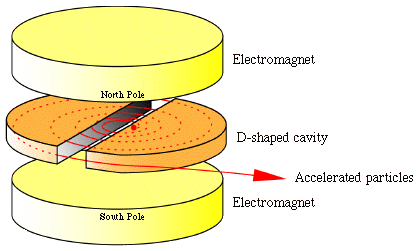Glossary
Cyclotron

A cyclotron is a machine used to accelerate charged particles to high energies. The first cyclotron was built by Ernest Orlando Lawrence and his graduate student, M. Stanley Livingston, at the University of California, Berkley, in the early 1930's.
A cyclotron consists of two D-shaped cavities sandwiched between two electromagnets. A radioactive source is placed in the center of the cyclotron and the electromagnets are turned on. The radioactive source emits charged particles. It just so happens that a magnetic field can bend the path of a charged particle so, if everything is just right, the charged particle will circle around inside the D-shaped cavities. However, this doesn't accelerate the particle. In order to do that, the two D-shaped cavities have to be hooked up to a radio wave generator. This generator gives one cavity a positive charge and the other cavity a negative charge. After a moment, the radio wave generator switches the charges on the cavities. The charges keep switching back and forth as long as the radio wave generator is on. It is this switching of charges that accelerates the particle.
Let's say that we have an alpha particle inside our cyclotron. Alpha particles have a charge of +2, so their paths can bent by magnetic fields. As an alpha particle goes around the cyclotron, it crosses the gap between the two D-shaped cavities. If the charge on the cavity in front of the alpha particle is negative and the charge on the cavity in back of it is positive, the alpha particle is pulled forward (remember that opposite charges attract while like charges repel). This just accelerated the alpha particle! The particle travels through one cavity and again comes to the gap. With luck, the radio wave generator has changed the charges on the cavities in time, so the alpha particle once again sees a negative charge in front of it and a positive charge in back of it and is again pulled forward. As long as the timing is right, the alpha particle will always see a negative charge in front of it and a positive charge in back of it when it crosses the gap between cavities. This is how a cyclotron accelerates particles!
Unfortunately, there's one more thing to worry about. The faster a charged particle moves, the less it is affected by a magnetic field. So, as particles speed up in a cyclotron, they spiral outwards. This makes it easy to get the particles out of the cyclotron, but also puts a limit on the amount of acceleration they can undergo.
Citation and linking information
For questions about this page, please contact Education Web Administrator.
